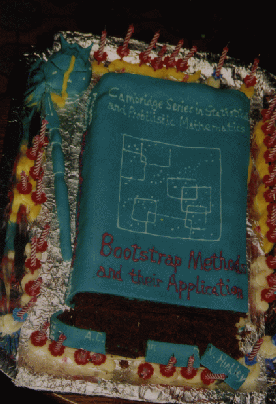 |
 |
|
|
|
|
|
 |
 |
|
|
|
|
|
How to order this book from Cambridge University Press.
Bootstrap Methods and Their Application is published by Cambridge University Press. The book is written by Anthony Davison, Professor of Statistics at the Swiss Federal Institute of Technology, Lausanne, and David Hinkley, Professor of Statistics at the University of California at Santa Barbara.
Here are errata (PDF).
Reviews of the book.
Questions or comments regarding the book should be addressed to
Note that the contents of these files are copyright of Cambridge University
Press, 1997.
Any questions, comments or problems with the data should be addressed
to Diego Kuonen at kuonen@statoo.com.
Jacket Blurb
Bootstrap methods are computer-intensive methods of statistical analysis that use simulation to calculate standard errors, confidence intervals and significance tests. The methods are not only in general use by statisticians, but also are applied by quantitative researchers in the life sciences, medical sciences, social sciences, business, econometrics, and other areas where statistics is used. The methods apply for any level of modelling, and so can be used for fully parametric, semiparametric, and completely nonparametric analysis. This book gives a broad and up-to-date coverage of bootstrap methods with numerous applied examples, together with the underlying general concepts and basic theory without emphasis on mathematical rigour.
Applications include stratified data; finite populations; censored and
missing data; linear, nonlinear, and smooth regression models; time series
and spatial problems. Special features of the book include: extensive discussion
of significance tests and confidence intervals; material on various diagnostic
methods; and methods for efficient computation, including improved Monte
Carlo simulation. Each chapter includes both practical and theoretical
exercises. A valuable supplement is a disk of purpose-written S-Plus programs
for implementing the methods described in the text. The emphasis is on
practicalities, with detailed examples of how to apply the methods, will
make the book indispensable to users, teachers and students of statistical
methods.
Chapter Contents
1. Introduction
2. The Basic Bootstraps
3. Further Ideas
4. Tests
5. Confidence Intervals
6. Linear Regression
7. Further Topics in Regression
8. Complex Dependence
9. Improved Calculation
10. Semiparametric Likelihood Inference
11. Computer implementation
Appendix. Cumulant Calculations
Bibliography
Index
Sample Pages
A postscript file of the table of contents, Preface, Chapter 1, and the start of Chapter 2 is available here (PS) or here (PDF).